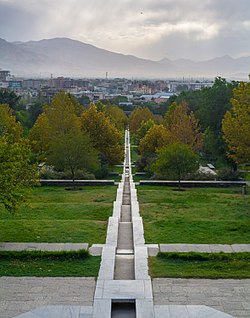
Back Багі Бабур Byelorussian বাগে বাবর Bengali/Bangla Bāgh-e Bābur CEB Bagh-e Babur Czech Bagh-e Babur German Bagh-e Babur Spanish Baburreko lorategiak Basque باغ بابر Persian Bagh-e Babor Finnish Bagh-e Babur French
| Bagh-e Babur | |
|---|---|
| Gardens of Babur | |
| باغ بابر | |
 Bagh-e Babur in September 2015 | |
 | |
| Location | Sher Darwaza, Kabul, Afghanistan[1] |
| Coordinates | 34°30′11″N 69°09′29″E / 34.503°N 69.158°E |
| Created | 1504[2] |
| Founder | Babur |
| Open | 7 am–8 pm |
| Status | Active |
| Parking | Yes |
Bagh-e Babur (Dari: باغ بابر), also known as Gardens of Babur, is a historic site in Chelsatun, Kabul, Afghanistan. It is located in the Sher Darwaza hillside of District 5, southwest of Shahr-e Naw, or a short distance south of Kabul Zoo and north of Chihil Sutun.[1] The gardens of Babur has several terraced buildings, a small mosque, and plenty of walking space. Visited by up to one million locals and foreign tourists a year,[1] it is also where the tomb of the first Mughal emperor Babur is located. The park is thought to have been developed around 1504,[2] when Babur gave orders for the construction of an "avenue garden" in Kabul, described in some detail in his memoirs, the Baburnama. It has been re-developed by various Afghan rulers since then.[3]
It was the tradition of Mughal princes to develop sites for recreation and pleasure during their lifetime and later choose one of these as their last resting place. The site continued to be of significance to Babur's successors; Jahangir made a pilgrimage to the site in 1607, when he ordered that all gardens in Kabul be surrounded by walls, that a prayer platform be laid in front of Babur's grave, and an inscribed headstone placed at its head.[4] During the visit of the Mughal Emperor Shah Jahan in 1638, a marble screen was erected around the tomb of Babur, and a mosque built on the terrace below. There are accounts from the time of the visit to the site of Shah Jahan in 1638 of a stone water channel that ran between an avenue of trees from the terrace below the mosque, with pools at certain intervals.
- ^ a b c Cite error: The named reference
Bagh-e-Babur Draws One Million Visitors A Yearwas invoked but never defined (see the help page). - ^ a b "Kabul Treated To Mughal Art Exhibition". TOLOnews. 2 April 2018. Retrieved 2023-05-17.
- ^ "In pictures: Kabul's Moghul garden". BBC. 6 November 2003. Retrieved 2023-05-17.
- ^ Jahangir, Emperor of Hindustan (1999). The Jahangirnama: Memoirs of Jahangir, Emperor of India. Translated by Thackston, Wheeler M. Oxford University Press. p. 77. ISBN 978-0-19-512718-8.